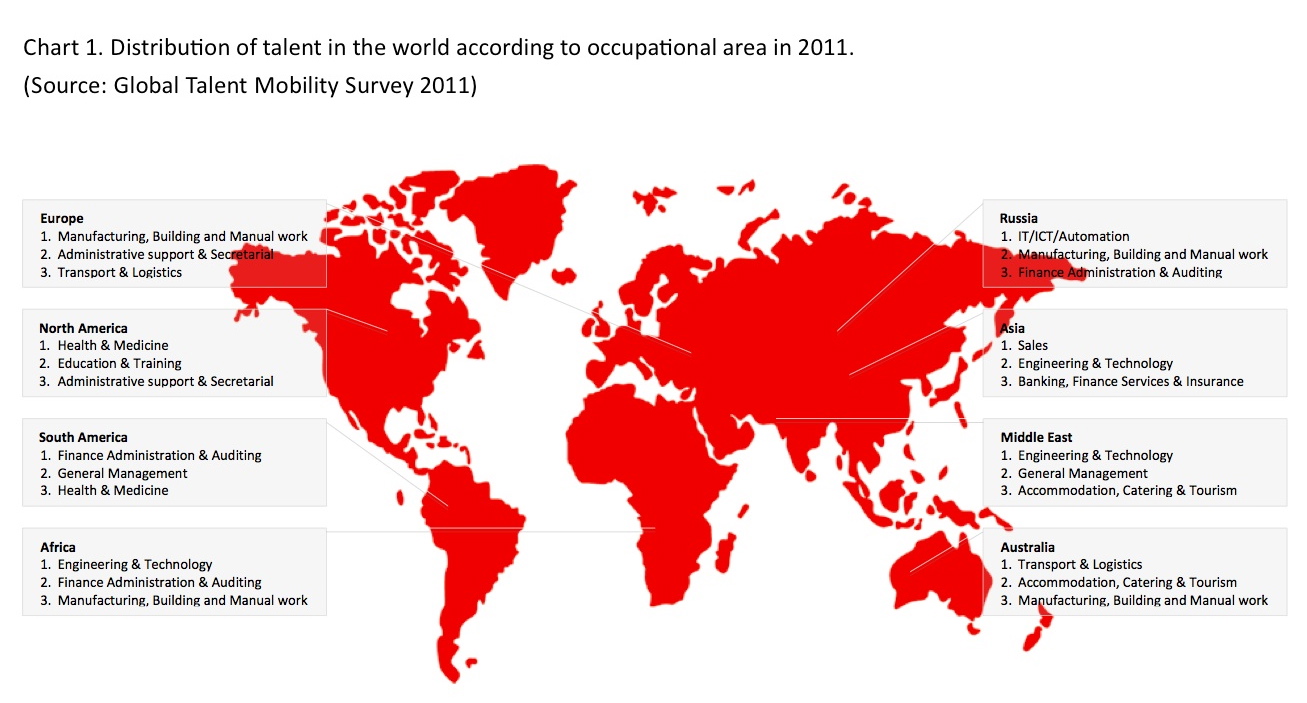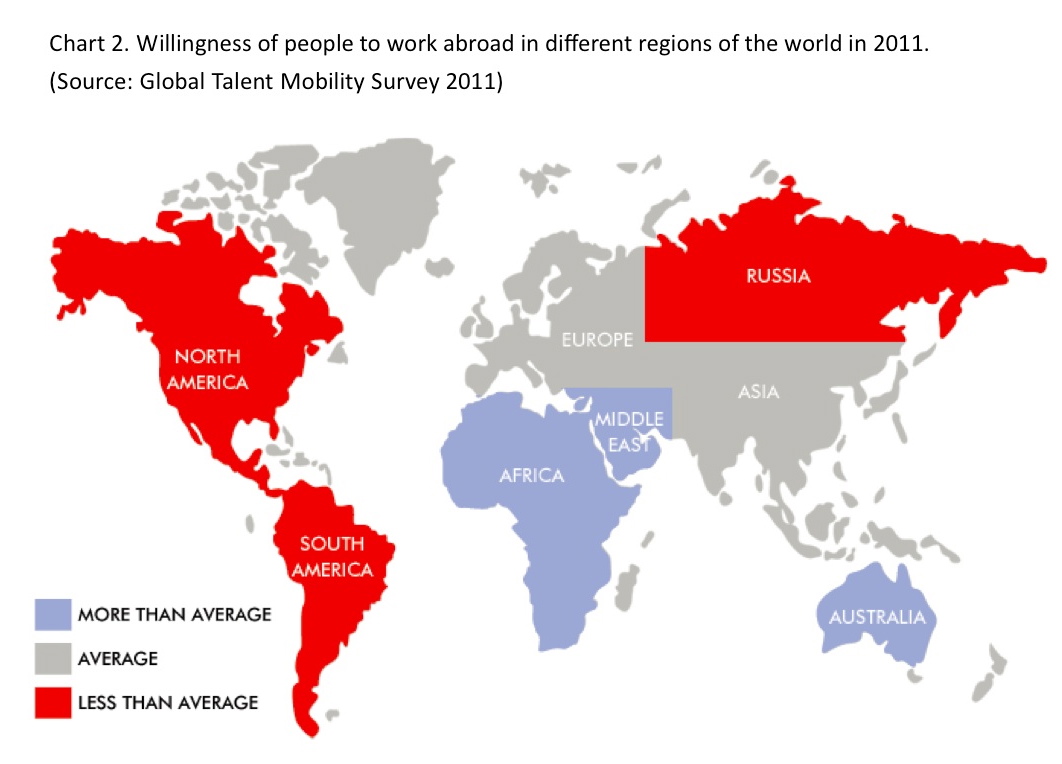Following up on my previous post about global labour market trends, this entry will focus on the topic of international recruitment. In particular, the increased international mobility of the global workforce goes hand in hand with a growing demand for international recruitment by companies. The Global Talent Mobility Survey (2011) identifies two main strategies that ensure successful international recruitment: the ‘work to people’ strategy and the ‘people to work’ strategy.
As the label ‘work to people’ implies, this approach entails moving some part (if not all) of the company to another country and then recruiting the local workforce. There are several possible justifications for such a move. First, expanding your business abroad is beneficial for both international branding and business growth. Second, from a staffing perspective, factors such as specific skill requirements and talent shortage in the home country can trigger business expansion abroad. Finally, if local workers of another country can do the same job with less cost, moving abroad also becomes a cost effective strategy.
Contrary to the ‘work to people’ strategy, the ‘people to work’ strategy aims at attracting international workers to the company’s home country. The key here lies in making employees relocate for the job (one example are self-initiated assignees). Similar to the previously discussed strategy, attracting foreign employees to the home country can be beneficial for building a company’s international profile, accessing new sources of skills and talents from abroad, while also potentially reducing cost if foreign workers are less demanding than local ones.
What determines which of the two strategies is more appropriate? Two key factors to consider are the number of people needed and the duration of the contract. More specifically, when planning on recruiting only a few employees, attracting from abroad seems to be an easier option. By contrast, when the recruitment volumes are high, it becomes more efficient to move part of the business and recruit locally in a new country. In a similar vein, considering the contract duration, the longer the period of time for which foreign workers are needed, the more business relocation should be considered. However, the authors note that even in the case of short-term projects, moving part of the business to a temporary location can be used as a talent corridor, which would cover more than one country and thus offering more opportunities for international recruitment. For example, Belgium, being a small country in proximity to Germany, France and the Netherlands, can serve as a good location for attracting employees also from the neighboring countries.
Apart from the guidelines on the choice of international recruitment strategy, the Global Talent Mobility Survey also draws some practical implications for each strategy.
Because recruiting people in their local labour markets (i.e., ‘work to people’ strategy) requires knowledge about that market, the authors highlight several aspects that characterize a national labour force. Specifically, the labour force can be described based on their demographic profile, occupational area, labour market activity, most popular industries, factors that motivate people to work for you, and commonly used job sources and titles. Several different national and international workforce surveys, consultancies and statistical databases could be used for obtaining such information. For example, in terms of occupational profile the Global Talent Mobility Survey indicates that ‘talented workers are spread across the world, with each continent having an above-average representation of people in specific occupational areas’ (see the following chart; click to enlarge).
When looking at the ‘people to work’ strategy, the authors argue that people who look for work abroad focus on different factors compared to domestic job searchers. Thus, from the employer’s perspective it is important to have an idea not only about demographic and occupational profiles of the potential incoming workforce, but also about their relocation-related factors. These include: willingness to work abroad, duration of the possible relocation, preferred destination countries and cities, main reasons to work abroad, key factors for choosing a company abroad, the most essential information needed from the employer (e.g. tax-related issues), and most commonly used international job sources.
To provide an example, the Global Talent Mobility Survey 2011 data indicate that Australian citizens are most willing to work abroad, with 87% of jobseekers expressing a desire to relocate for work. Australian preferences of working abroad are closely followed by Africans (86%). The least international aspirations are shown by jobseekers from North America (52%) and South America (57%). Europe (71%), Asia (68%) and Russia (61%) are placed somewhere in between (see the following chart; click to enlarge).
When looking more specifically at the top 5 preferred countries and cities on the global scale, the descending order is as follows: USA, UK, Canada, Australia, Germany; and London, New York, Singapore, Paris, Sydney.
All in all, international recruitment strategies imply a great deal of knowledge about the labour market that the company is trying to recruit from, as well as its jobseekers’ preferences and characteristics. Last but not least it should be mentioned that apart from focusing on the characteristics of jobseekers, building an internationally oriented employer brand is also vital. And of course, selection instruments need to be carefully designed and culturally adapted to ensure that the best fitting candidate is finally hired, no matter where he or she is coming from.




Hi Sebastian,
I work for a recruitment agency in Manchester and we have just begun working with clients in USA. Candidates in the USA, applying for USA based roles have very different expectations from employers than UK based candidates applying for the same roles. We have found candidates in the USA are willing to relocate further for a role within the USA than UK based candidates applying for UK based roles.
International recruitment department has been declined too many students application. i am also one them its very difficult to me manage there process to apply there.
These include: willingness to work abroad, duration of the possible relocation, preferred destination countries and cities, main reasons to work abroad, key factors for choosing a company abroad, the most essential information needed from the employer (e.g. tax-related issues), and most commonly used international job sources.
We have found candidates in the USA are willing to relocate further for a role within the USA than UK based candidates applying for UK based roles.The most essential information needed from the employer (e.g. tax-related issues), and most commonly used international job sources.
Hey,
This is me, Samuel, a Recruitment Agent at leading Recruitment Agency in Nepal since 2008 and agency is working for those people those who want to relocate in the USA for their future career.